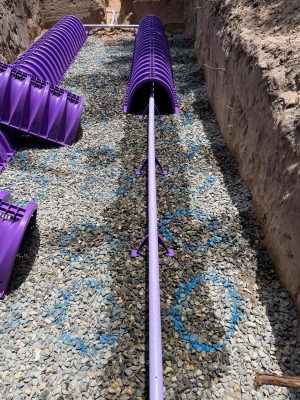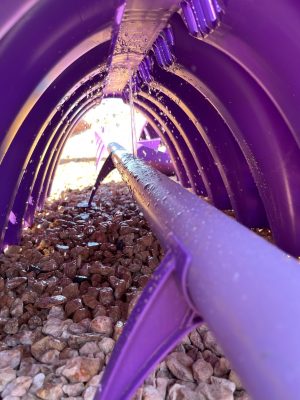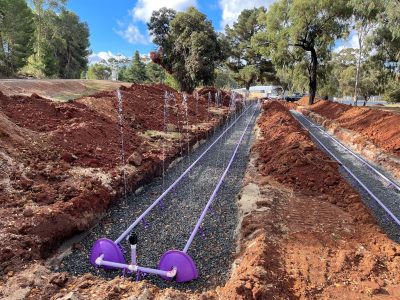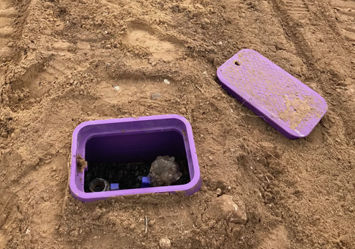ABSORBS™ Pressure-Dosed Irrigation Trench System
The ABSORBS™ pressure-dosed irrigation trench system is a versatile, sub-surface dispersal platform designed to ensure a uniform and balanced delivery of pressure-dosed effluent over the maximum dispersal design area.
This innovative technology amalgamates a number of recognised ‘best practice’ design, distribution and dispersal techniques and fully complies with the requirements of Australian Standard AS/NZS 1547:2012. A key benefit of the technology is that oxygen levels in the irrigated wastewater and in the receiving soil trench environment are maximized by the unique, purpose-engineered flat ridge along the crown of the proprietary structure. The increased oxygen is highly beneficial both for plants surrounding the trench and also for beneficial microbes in the underlying trench substrate which help achieve advanced levels of wastewater treatment.
The ABSORBS™ pressure-dosed irrigation trench system consists of a proprietary tunnel structure through which pressure dosed effluent is pumped and dispersed via a network of pressure piping elevated on purpose-engineered trivets to create a permanent 150 mm annular air gap between the dosing bed and effluent dispersal piping. The elevated delivery pipe mitigates against root intrusion which is the number one cause of sub-surface dispersal system clogging and failure.
Key benefits of ABSORBS™ pressure-dosed irrigation trench system
- Patented design delivers passive aeration and treatment
- Easy installation with interlocking, overlapping tunnel design
- Patented catenary arch structure is the strongest tunnel on the market
- Energy efficient operation
- Improved area of water distribution across dispersal bed reduces load on soil
- Improved uniformity of water distribution prevents spot-loading
- Controlled intermittent pressure dosing promotes aerobic soil conditions
- Best practice design prevents plant root intrusion
- Durable recycled plastic construction
- Made in Australia from recycled plastic

Fig.2. Typical ABSORBS™ tunnel under test showing fine droplet spread within the tunnel structure.

Fig 1. Pressure delivery of wastewater within the proprietary tunnel structure achieves fine droplets both above and within the tunnel structure, achieving increased water droplet surface-to-air ratio to naturally oxygenate the water prior to infiltration into the upper soil mantle.
Overview
The ABSORBS™ pressure-dosed irrigation trench system uses a unique pressurised ‘tunnel splash back’ style distribution technique successfully developed under local conditions in South Australia. Pressurised treated water is forced through a series of defined pipe apertures against the underside of the tunnel. This high velocity water delivery against the purpose-engineered flat ridge tunnel crown creates an aerosolising effect which effectively provides passive aeration of incoming wastewater, while also achieving a highly uniform wetted area distribution over the entire footprint of the tunnel.
The ABSORBS™ pressure-dosed irrigation trench system requires no root intrusion chemicals and exploits the pumping energy already expended to elevate the dissolved oxygen concentration by aerosolising the wastewater stream into fine droplets within a naturally aerobic sub-surface tunnel system (Figure 1).
The dramatic increase in water droplet surface-to-air ratio improves water–air contact potential during water delivery, promoting aerobic wastewater conditions prior to uniform
intermittent delivery over the entire footprint of the dispersal bed. An example of the uniform wetting pattern achieved by ABSORBS™ dispersal technology is demonstrated in Figure 2. The intermittent uniform dispersal serves to maintain naturally aerobic conditions, helping prevent dispersal system failure due to localized overloading and clogging, while also preventing odours.

Oxygen within the tunnel environment is constantly replenished by natural mass exchange of atmospheric oxygen into the upper soil mantle and tunnel system, and through direct surface venting in very large installations. It is therefore a critical design condition that the ABSORBS™ pressure-dosed irrigation trench remains unobstructed from impervious materials such as concrete, paving, weed mats, rain water tanks and parked caravans/vehicles. To maintain healthy soil for optimum oxygen transfer and water exchange to the atmosphere, it is also important to avoid compacting overlying soil by regular vehicle traffic.
Design improves both water distribution area and uniformity of water distribution
>500% improvement in water distribution and uniformity of distribution across the receiving soil compared to conventional piped pressure trench as per AS 1547:2012.
>300% improvement in water distribution and uniformity of distribution across the receiving soil compared to conventional pressure dosed arched trench as per AS 1547:2012.
Dual zone water delivery
‘Dual zone’ water delivery is achieved by having a series of apertures at the crest of the tunnel deliver water to the upper active soil profile where most of the soil biology lives as well as where maximum evapo-transpiration occurs (i.e. maximum water loss to atmosphere).
Designed to optimise water distribution
The engineered shape of the tunnel (flat ridge at the crest) creates a surface for maximum impact of incoming pressure dosed water and maximum aeration and distribution of water within the tunnel to maintain fully aerobic conditions within the receiving soil/sand environment.
Root intrusion management
The use of trivets to keep pressure pipe elevated 150 mm off the ground creates a permanent air gap to ‘air prune’ roots and prevent root intrusion which is THE NUMBER 1 cause of failure in other trench systems.
Distribution pipes are supported on purpose-engineered trivets to create a permanent 150 mm annular air gap between the dosing bed Among the many benefits of this engineered pipe support structure is the well documented outcome of ‘air root pruning’ whereby any emerging roots entering the system are desiccated within the air barrier and effectively killed off whilst still ensuring the health of the broader root system. Preventing root intrusion without the introduction of toxic herbicides further reduces impacts on sensitive receiving environments and retains the rhizo-remediation benefits of the adjacent root zone. These include the ongoing assimilation of nutrients, the reduction of hydraulic pressure on the receiving soils, maintenance of aerobic soil conditions and the symbiotic improvements to healthy microbial activity. The trivets also secure the dosing laterals central within the bed and support them to remain clear of any potential sludge accumulation on the media bed.

Fig.4. Typical flushing valves located at terminal ends of the pressure distribution pipeline allow for periodic minimal maintenance to ensure pipes remain free of blockages. NB. Valves are not to be connected to any potable water pipes or garden hoses.
Flushing valves
Wastewater from the pump enters the bed and terminates at the distal point of each dispersal bed with a 40 mm full flow lilac coded flushing valve positioned within a heavy-duty lilac valve enclosure as shown in Figure 4. The valves both identify position and extent of the network and allow for periodic flushing of the distribution lateral. The use of 40 mm full flow diameter valve and pressure PVC lines accommodates a Hydrojet drain cleaner in the event that flushing valves are unable to clear blockages. The lilac colour is to indicate wastewater and therefore not suitable for potable uses. Flushed water drains into the gravel bed under the valve boxes and dries between flushing events. These boxes are not to be driven on by any vehicle. Installer is not to cross connect any potable water service onto the valves.
Traffic Management
The ABSORBS™ dispersal system is not designed for vehicular traffic; however, occasional light traffic from ride-on lawn mowers or tractors not exceeding 500 kg should not damage or affect the performance of the system. No vehicles are to park on the system or to traverse any valve box at any time. Traffic events, either vehicular or heavy pedestrian foot traffic, should be spread out over the year to allow vegetation to fully recover and be set up to prevent over-compaction of the soil overlying the ABSORBS™ system, for example spread out the event over as large an area as possible. Coring/aeration of the soil is recommended after large events or as required to manage soil compaction.
Contact Arris to find out more about our specialised water technology solutions.
For more information on Pressurised Distribution Systems, the Washington State Department of Health have published new guidelines, Pressure Distribution Systems – Recommended Standards and Guidance for Performance, Application, Design, and Operation & Maintenance.
